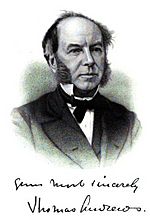Thomas Andrews (scientist) facts for kids
Quick facts for kids
Thomas Andrews
FRS FRSE
|
|
|---|---|
 |
|
| Born | 19 December 1813 Belfast, Ireland
|
| Died | 26 November 1885 (aged 71) Belfast, Ireland
|
| Alma mater | University of Glasgow |
| Known for | Phase transitions |
| Awards | Royal Medal (1844) |
| Scientific career | |
| Fields | Chemistry Physics |
Thomas Andrews (born December 19, 1813 – died November 26, 1885) was an important Irish chemist and physicist. He is famous for his studies on how gases turn into liquids. He taught chemistry for many years at Queen's University of Belfast.
Life of Thomas Andrews
Thomas Andrews was born in Belfast, Ireland. His father was a linen merchant. Thomas went to school at the Belfast Academy. He also studied math at the Royal Belfast Academical Institution.
In 1828, he went to the University of Glasgow to study chemistry. Later, he studied at Trinity College, Dublin. He earned his medical degree from the University of Edinburgh in 1835.
After finishing his studies, Andrews became a successful doctor in Belfast. He also taught chemistry. In 1845, he became the vice-president and a chemistry professor at the new Queen's University of Belfast. He worked there until he retired in 1879. Thomas Andrews passed away in 1885. He was buried in Belfast.
In 1842, Thomas Andrews married Jane Hardie Walker. They had six children together. One of their children, Mary Andrews, became a geologist.
Andrews' Scientific Work
Thomas Andrews first became known for his work on how much heat is made during chemical reactions. For this work, he received the Royal Medal in 1844.
His most famous work was about how gases can turn into liquids. In the 1860s, he studied the rules that gases follow. These rules explain how pressure, temperature, and volume are related in gases like carbon dioxide.
Andrews discovered important ideas called the critical temperature and critical pressure. He showed that a substance can change from a gas to a liquid without any sudden breaks. It's a continuous change. He explained that:
- The gas and liquid forms are just different stages of the same material.
- They can change into each other smoothly.
Andrews' experiments showed that carbon dioxide could go from being a liquid to a gas without losing its uniform state. His discoveries were very important. They helped other scientists try to turn different gases into liquids. For example, in 1877-78, Louis Paul Cailletet was the first to make oxygen into a liquid.


